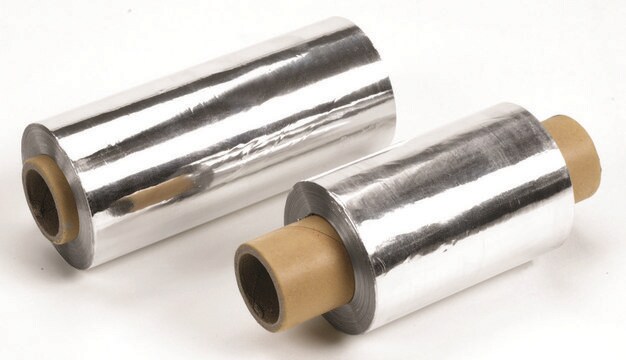266574
Aluminum
foil, thickness 0.45-0.55 mm, 99.999% trace metals basis
About This Item
Produits recommandés
Agence
suitable for EPA OTM-45
Niveau de qualité
Essai
99.999% trace metals basis
Forme
foil
Température d'inflammation spontanée
1400 °F
Résistivité
2.6548 μΩ-cm
Épaisseur
0.45-0.55 mm
pb
2460 °C (lit.)
Pf
660.37 °C (lit.)
Densité
2.7 g/mL at 25 °C (lit.)
Application(s)
PFAS testing
battery manufacturing
Chaîne SMILES
[Al]
InChI
1S/Al
Clé InChI
XAGFODPZIPBFFR-UHFFFAOYSA-N
Catégories apparentées
Quantité
- 50×50 mm (approximately 3.4 g)
- 100×100 mm (approximately 13.6 g)
Code de la classe de stockage
11 - Combustible Solids
Classe de danger pour l'eau (WGK)
WGK 3
Point d'éclair (°F)
Not applicable
Point d'éclair (°C)
Not applicable
Équipement de protection individuelle
Eyeshields, Gloves, type N95 (US)
Faites votre choix parmi les versions les plus récentes :
Déjà en possession de ce produit ?
Retrouvez la documentation relative aux produits que vous avez récemment achetés dans la Bibliothèque de documents.
Les clients ont également consulté
Articles
In many technologies, performance requirements drive device dimensions below the scale of electron mean free paths (λe). This trend has increased scientific interest and technological importance of electrical resistivities at the nanoscale.
Can there be an effective strategy for finding breakthrough materials, since they are, by definition, unpredictable? One answer is found in Combinatorial Materials Science techniques, which represent a powerful approach to identifying new and unexpected materials.
Biomedical implants are essentially foreign substances within the human body that must survive many years’ exposure to demanding mechanical and physiological conditions. Despite these challenges, metal implants have been widely used to substitute for or rebuild hard tissues such as bones and teeth.
The unique properties of the rare-earth elements and their alloys have brought them from relative obscurity to high profile use in common hightech applications.
Global Trade Item Number
| Référence | GTIN |
|---|---|
| 266574-100CM2 | 4061833321034 |
| 266574-13.6G | |
| 266574-25CM2 | 4061833321058 |
| 266574-3.4G |
Notre équipe de scientifiques dispose d'une expérience dans tous les secteurs de la recherche, notamment en sciences de la vie, science des matériaux, synthèse chimique, chromatographie, analyse et dans de nombreux autres domaines..
Contacter notre Service technique

